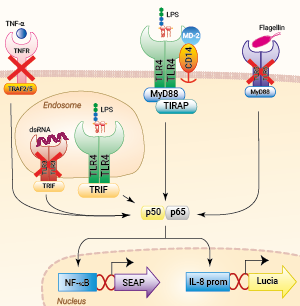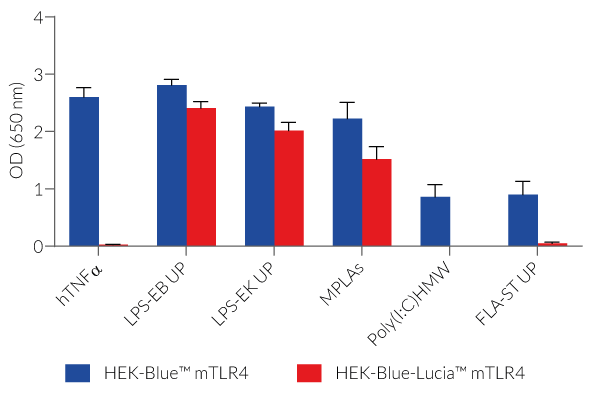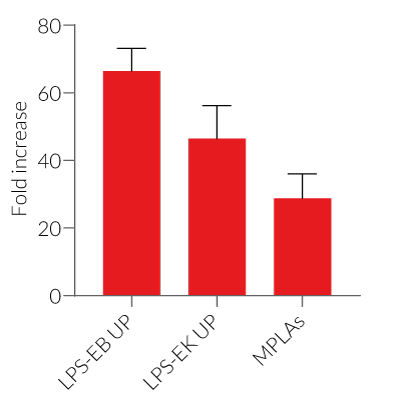Mouse TLR4 HEK293 Reporter Cells (NF-κB and IL-8)
| Product | Unit size | Cat. code | Docs. | Qty. | Price | |
|---|---|---|---|---|---|---|
|
HEK-Blue-Lucia™ mTLR4 Cells Murine TLR4 expressing HEK293 dual reporter cells (NF-κB pathway) |
Show product |
3-7 x 10e6 cells |
hkd-mtlr4ni
|
|
||
|
HEK-Blue-Lucia™ mTLR4 vial Additional cell vial |
Show product |
3-7 x 10e6 cells |
hkd-mtlr4ni-av
|
Notification: Reference #hkd-mtlr4ni-av can only be ordered together with reference #hkd-mtlr4ni.
NF-κB–SEAP and IL-8–Lucia reporter HEK293 cells expressing murine TLR4

Signaling pathways in HEK-Blue-Lucia™ mTLR4 cells
HEK-Blue-Lucia™ mTLR4 cells* were engineered from the human embryonic kidney HEK293 cell line to study the mouse Toll-like receptor 4 (mTLR4)-dependent NF-κB pathway upon stimulation with lipopolysaccharide (LPS). LPS is a major constituent of the outer membrane of Gram-negative bacteria and the main microbial mediator implicated in the pathogenesis of sepsis and septic shock [1].
Description
HEK-Blue-Lucia™ mTLR4 cells were generated from the HEK-Blue-Lucia™ Null cell line harboring two inducible reporter genes. This feature allows the double readout of the NF-κB/AP-1 pathway, by monitoring the SEAP (secreted embryonic alkaline phosphatase) or Lucia luciferase activities. HEK-Blue-Lucia™ mTLR4 cells also stably express the genes for mTLR4, MD-2 (myeloid differentiation factor 2), and CD14 (cluster of differentiation 14). Due to a triple knockout (KO) of TLR3, TLR5, and TNFR, this cell line allows for the independent study of TLR4.
Stimulation of HEK-Blue-Lucia™ mTLR4 cells with TLR4 agonists (e.g. lipopolysaccharide) triggers the activation of the artificial NF-κB-inducible promoter and the subsequent production of SEAP. It also promotes the expression of Lucia luciferase, which is knocked in (KI) downstream of the endogenous (more physiological) IL-8 promoter (see figures).
IL-8 (interleukin 8) is a chemokine produced in response to TLR agonists in an NF-κB/AP-1-dependent manner [1-2]. This feature enables the double readout study of the NF-κB/AP-1 pathway, by monitoring the activity of SEAP and Lucia luciferase using QUANTI-Blue™ Solution (SEAP detection reagent) or QUANTI-Luc™ 4 Lucia/Gaussia (luciferase detection reagent), respectively. Thus, you may choose the readout depending on your laboratory equipment utilizing a spectrophotometer for SEAP or a luminometer for Lucia luciferase detection.
Key features
- Stable overexpression of mouse TLR4, MD2, and CD14
- Verified KO for the TLR3, TLR5, and TNFR genes
- Functionally validated using a selection of PRR ligands and cytokines
- Readily assessable NF-κB activation by assessing the SEAP and/or Lucia luciferase activities
Applications
- Defining the role of TLR4-dependent NF-κB signaling pathway
- Screening for novel TLR4 agonists and inhibitors
- Choice of readout depends on the laboratory equipment (spectrophotometer for SEAP or luminometer for Lucia luciferase detection).
* Note: This cell line has been renamed. It was formerly known as "HEK-Dual™ mTLR4 (NF/IL8)". The cat. code (hkd-mtlr4ni) remains unchanged.
References:
1. Roebuck KA. 1999. Regulation of interleukin-8 gene expression. J Interferon Cytokine Res:429-38.
2. Ohta K, et al. 2014. Toll-like receptor (TLR) expression and TLR‑mediated interleukin-8 production by human submandibular gland epithelial cells. Mol Med Rep. (5):2377-82.
3. Cochet, F. et al. 2017. The Role of Carbohydrates in the Lipopolysaccharide (LPS)/Toll-Like Receptor 4 (TLR4) Signalling. Int J Mol Sci 18.
Specifications
Antibiotic resistance: Blasticidin, Hygromycin, Zeocin®
Growth medium: DMEM, 4.5 g/l glucose, 2 mM L-glutamine, 10% (v/v) heat-inactivated fetal bovine serum, 100 U/ml penicillin, 100 μg/ml streptomycin, 100 μg/ml Normocin™
Quality Control:
- The stable expression of mTLR4, MD-2, and CD14 has been verified by RT-qPCR and functional assays.
- The triple KO of TLR3, TLR5, and TNFR has been verified by DNA sequencing, PCR, and functional assays.
- The stability for 20 passages, following thawing, has been verified.
- These cells are guaranteed mycoplasma-free.
Note: HEK-Blue-Lucia™ mTLR4 cells are resistant to Blasticidin, Hygromycin, and Zeocin®. They should be maintained in growth medium supplemented with Hygromycin and Zeocin®.
Back to the topContents
- 3-7 x 106 cells in a cryovial or shipping flask.
- 1 ml of Hygromycin B Gold (100 mg/ml)
- 1 ml of Zeocin® (100mg/ml)
- 1 ml of Normocin™ (50 mg/ml)
- 1 ml of QB reagent and 1 ml of QB buffer (sufficient to prepare 100 ml of QUANTI-Blue™ Solution, a SEAP detection reagent)
- 1 tube of QUANTI-Luc™ 4 Reagent, a Lucia luciferase detection reagent (sufficient to prepare 25 ml)
![]() Shipped on dry ice (Europe, USA, Canada, and some areas in Asia)
Shipped on dry ice (Europe, USA, Canada, and some areas in Asia)
FAQ Cell Lines
 Any questions about our cell lines ? Visit our frequently asked questions page
Any questions about our cell lines ? Visit our frequently asked questions page
Back to the top
Details
The Toll-like receptor 4 (TLR4) was the first TLR identified and is an important pattern recognition receptor (PRR) in innate immunity and inflammation. It is found both on the cell surface and in endosomes of innate immune cells including monocytes and macrophages, as well as on intestinal epithelium and endothelial cells [1]. TLR4 can recognize pathogen- and damage-associated molecular patterns (PAMPs and DAMPs). However, it is primarily activated by lipopolysaccharide (LPS) and its toxic moiety Lipid A [2]. TLR4 does not directly interact with LPS but requires essential adaptor proteins [3]. The soluble LPS-binding protein (LBP) extracts monomeric LPS from the microbial membrane and transfers it to CD14 (cluster of differentiation 14). This membrane-bound protein then interacts with MD-2 (myeloid differentiation factor 2), which is constitutively associated with the TLR4 ectodomain. The ligand-loaded MD-2 subsequently binds to another TLR4/MD-2/LPS complex, leading to their dimerization [4]. Interestingly, TLR4 is the only TLR able to trigger two distinct signaling cascades [5]:
- the MyD88-dependent activating NF-κB pathway (at the cell surface)
- the TRIF-dependent activating IRF pathway (in endosomes)
At the cell surface, activation of TLR4 initiates the TIRAP-MyD88-dependent pathway, ultimately leading to the activation of NF-κB and the production of a pro-inflammatory response. Also, the TLR4 complex can be endocytosed into endosomes in a CD14-mediated fashion. This results in the stimulation of IRF3 (interferon regulatory factor), which modulates the expression of type I IFN [3].
TLR4 signaling is crucial in both acute and chronic inflammatory disorders and thus, is an attractive target for novel treatments [1]. Stimulating drugs are useful for the development of vaccine adjuvants or cancer immunotherapeutics, whereas TLR4-inhibition is a therapeutic approach to treat septic shock or autoimmune inflammatory pathologies such as atherosclerosis [5].
References:
1. Ou, T. et al. 2018. The Pathologic Role of Toll-Like Receptor 4 in Prostate Cancer. Front Immunol 9, 1188.
2. Cochet, F. et al. 2017. The Role of Carbohydrates in the Lipopolysaccharide (LPS)/Toll-Like Receptor 4 (TLR4) Signalling. Int J Mol Sci 18
3. Kuzmich, N.N. et al. 2017. TLR4 Signaling Pathway Modulators as Potential Therapeutics in Inflammation and Sepsis. Vaccines (Basel) 5.
4.Tanimura N. et al. 2014. The attenuated inflammation of MPL is due to the lack of CD14-dependent tight dimerization of the TLR4/MD2 complex at the plasma membrane. Int Immunol. (6):307-14.
5. Romerio A, Peri F. 2020. Increasing the Chemical Variety of Small-Molecule-Based TLR4 Modulators: An Overview. Front Immunol.;11:1210.








